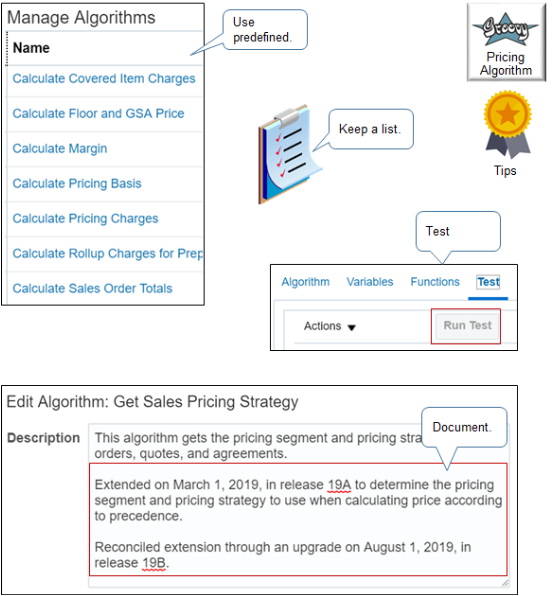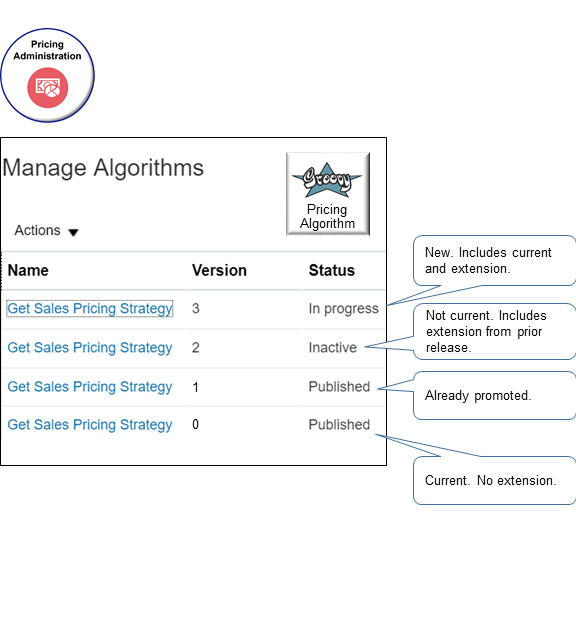Manage Modifications Through Updates
Reconcile the modifications that you made in earlier updates into the latest update.
Overview
The latest update might include new features, performance improvements, and corrections that affect your extended pricing algorithms. Reconcile means you test the changes that the latest update makes to your extended pricing algorithms in a test environment before you promote them to your production environment. Reconcile helps to make sure your extended algorithms work as expected.
Here's a summary of what you need to do.
- Determine whether you still need each of your extended algorithms. See the Remove Extended Algorithms That You Don't Need section later in this topic.
-
Install the latest update.
- Do this in a test environment:
- Identify your extended algorithms. See the Tips for Managing Extended Algorithms section later in this topic.
- Reconcile your extended algorithms. See the example later in this topic.
- Promote all pricing algorithms. See Promote Pricing Algorithms Into the Latest Update.
- Test your extended algorithms as part of your transaction flows. See Test and Troubleshoot Pricing Algorithms.
- Migrate your extended algorithms from the test environment to a production environment. See Migrate Pricing Algorithms from Test to Production.
- Do this in a production environment:
- Promote all pricing algorithms.
- Test your transaction flows again.
Remove Extended Algorithms That You Don't Need
An update might affect some of the functionality that your extension implemented. For example, assume the update includes a new manual price adjustment feature. You must disable any extended algorithms that you created for manual price adjustment because manual price adjustments are now part of the update.
For another example, assume the update includes an override net price feature. If you added an extended algorithm that overrides net price in an earlier update, then you must disable it in the latest update.
-
Learn about new features and corrections that Oracle Pricing introduces in each update. Evaluate whether they replace your extended algorithms. For details, see the What's New section and the Readiness Training section at Oracle Cloud Application Update Readiness.
-
For each new feature that replaces your extended algorithm:
-
Deactivate and remove any extended algorithm that involves the feature.
-
Remove any service mappings you created that involves the feature.
-
Tips for Managing Extended Algorithms

Minimize management, maintenance, and troubleshooting:
-
Use predefined algorithms instead of extending algorithms, when possible.
-
If the predefined algorithms don't meet your needs, then extend a predefined algorithm.
-
If extending a predefined algorithm doesn't meet your needs, then create a new one.
-
Keep a list of the algorithms that you extend. Use it to help identify your extended algorithms when you install the latest update to make sure you don't overlook one.
-
Use the Description in each extended algorithm to document your extension.
-
Test each extended algorithm after you install the latest update.
Example
Assume you set up a pricing strategy in an earlier update and your strategy references different pricing segments according to pricing precedence. Assume you:
-
Modified the matrix class so it includes a new result dimension that equals Precedence.
-
Assigned the pricing strategy so it uses Precedence.
-
Modified the pricing algorithm.
Here's what you must do.
-
Finish installing the latest update.
- Log into your test environment.
-
Use the Edit Matrix Class page to examine the Sales Pricing Strategy Assignment matrix class that you modified. Make sure it includes the Precedence column that you added in the earlier update, and it includes the default value of 10.
-
Use the Manage Pricing Strategy Assignments page to make sure it includes the pricing strategy assignment that you added in the earlier update.
Assume you did the setup in Assign Pricing Strategy According to Precedence and have already added these assignments:
Pricing Segment
Pricing Strategy
Pricing Precedence
Corporate Pricing Segment
Corporate Pricing Strategy
10
International Pricing Segment
International Pricing Strategy
20
Domestic Pricing Segment
Domestic Pricing Strategy
30
-
Go to the Manage Algorithms page and verify that it includes Version 2 of the Get Sales Pricing Strategy algorithm.

Note
Version Description 3
The version that you will create to bring your extended algorithm from the prior update into the latest update. 2 The version that you that extended in the prior update as part of this example. The update automatically brings your extended algorithms from the prior update into the latest update, but version 2 doesn't include the changes Oracle made as part of the update, so you will deactivate it. 1 The version that you already promoted. 0 The version that Oracle includes in the latest update. It includes changes that Oracle made as part of the update, but it doesn't include your extensions. You will create a new version 3 from version 0
-
Click the row that includes version 0, and then click Actions > Create Version.
Pricing creates version 3. It's identical to version 0.
-
Click the link in the row that includes version 3.
-
On the Edit Algorithm page, add a line to the description that indicates you reconciled an extended algorithm through an update.
Attribute
Value
Description
This algorithm gets the pricing segment and pricing strategy for sales orders, quotes, and agreements.Extended on January 1, 2024, in update 24A to determine the pricing segment and pricing strategy to use when calculating price according to precedence.Reconciled extended algorithm through an update on March 1, 2024, in update 24B.Make sure you include the date and update. For example:
Reconciled extension through an update on March 1, 2024, in update 24B. -
Reconcile your changes.
-
Click the Get Header Strategy step.
-
In the Data Sets area, click the row that includes Matrix in the Name attribute.
-
Set the Order By attribute to Precedence.
-
Click Save and Close.
Recall that you made this change in Assign Pricing Strategy According to Precedence. You must reconcile each change that you made.
-
- Promote your pricing algorithm.
-
Refresh the Manage Algorithms page.
You must refresh to display the correct version. Use the filter to query the list.
-
Click the row that includes version 2, then click Actions > Deactivate.
You don't need the old version, so it's helpful to deactivate it to avoid confusion across versions.
-
Click the row that includes version 3, then click Actions > Publish.
-
Test your changes.
-
Sign out of Oracle Pricing, then sign into Oracle Applications with the privileges that you need to manage sales orders.
The browser caches the pricing algorithm. You must sign out, and then sign in to refresh the browser's cache.
-
Go to the Order Management work area, create a sales order, then make sure it assigns the pricing strategy according to precedence.
-
-
Troubleshoot your changes.
-
Use the View Source feature to compare the new algorithm's source code to your extended algorithm.
-
Pricing uses the algorithm's highest, published version. Make sure the highest version contains your extensions.
-
Refresh the browser cache. Make sure you sign out of Order Management and sign back in each time you publish the algorithm.
-
- Migrate your extended algorithm from the test environment to a production environment.
- Log into your production environment, promote your pricing algorithm, then test your transaction flows again.
For more details about versions, see Promote Pricing Algorithms Into the Latest Update and Migrate Pricing Algorithms from Test to Production.